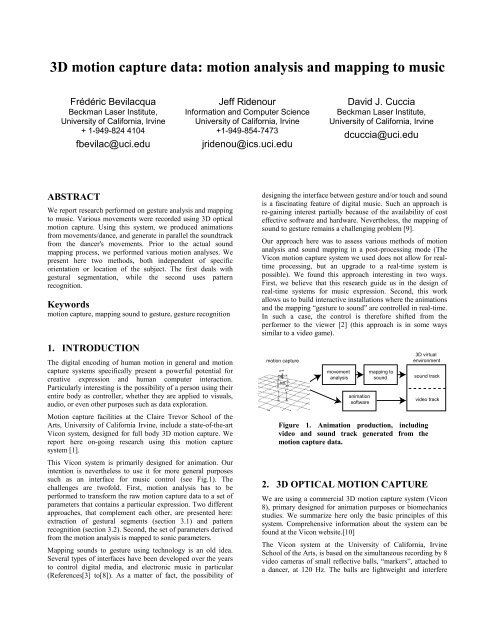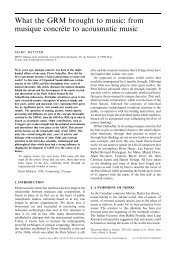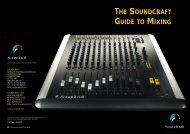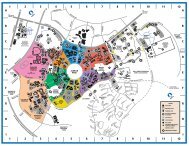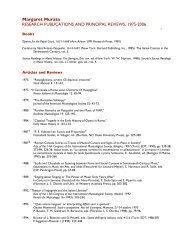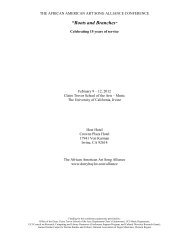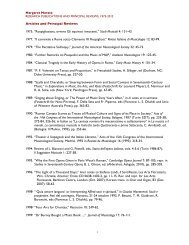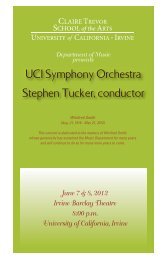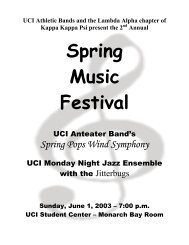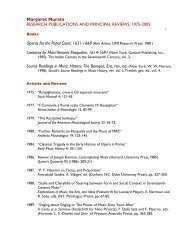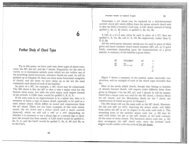3D motion capture data: motion analysis and mapping to music
3D motion capture data: motion analysis and mapping to music
3D motion capture data: motion analysis and mapping to music
Create successful ePaper yourself
Turn your PDF publications into a flip-book with our unique Google optimized e-Paper software.
<strong>3D</strong> <strong>motion</strong> <strong>capture</strong> <strong>data</strong>: <strong>motion</strong> <strong>analysis</strong> <strong>and</strong> <strong>mapping</strong> <strong>to</strong> <strong>music</strong><br />
Frédéric Bevilacqua<br />
Beckman Laser Institute,<br />
University of California, Irvine<br />
+ 1-949-824 4104<br />
fbevilac@uci.edu<br />
Jeff Ridenour<br />
Information <strong>and</strong> Computer Science<br />
University of California, Irvine<br />
+1-949-854-7473<br />
jridenou@ics.uci.edu<br />
David J. Cuccia<br />
Beckman Laser Institute,<br />
University of California, Irvine<br />
dcuccia@uci.edu<br />
ABSTRACT<br />
We report research performed on gesture <strong>analysis</strong> <strong>and</strong> <strong>mapping</strong><br />
<strong>to</strong> <strong>music</strong>. Various movements were recorded using <strong>3D</strong> optical<br />
<strong>motion</strong> <strong>capture</strong>. Using this system, we produced animations<br />
from movements/dance, <strong>and</strong> generate in parallel the soundtrack<br />
from the dancer's movements. Prior <strong>to</strong> the actual sound<br />
<strong>mapping</strong> process, we performed various <strong>motion</strong> analyses. We<br />
present here two methods, both independent of specific<br />
orientation or location of the subject. The first deals with<br />
gestural segmentation, while the second uses pattern<br />
recognition.<br />
Keywords<br />
<strong>motion</strong> <strong>capture</strong>, <strong>mapping</strong> sound <strong>to</strong> gesture, gesture recognition<br />
1. INTRODUCTION<br />
The digital encoding of human <strong>motion</strong> in general <strong>and</strong> <strong>motion</strong><br />
<strong>capture</strong> systems specifically present a powerful potential for<br />
creative expression <strong>and</strong> human computer interaction.<br />
Particularly interesting is the possibility of a person using their<br />
entire body as controller, whether they are applied <strong>to</strong> visuals,<br />
audio, or even other purposes such as <strong>data</strong> exploration.<br />
Motion <strong>capture</strong> facilities at the Claire Trevor School of the<br />
Arts, University of California Irvine, include a state-of-the-art<br />
Vicon system, designed for full body <strong>3D</strong> <strong>motion</strong> <strong>capture</strong>. We<br />
report here on-going research using this <strong>motion</strong> <strong>capture</strong><br />
system [1].<br />
This Vicon system is primarily designed for animation. Our<br />
intention is nevertheless <strong>to</strong> use it for more general purposes<br />
such as an interface for <strong>music</strong> control (see Fig.1). The<br />
challenges are twofold. First, <strong>motion</strong> <strong>analysis</strong> has <strong>to</strong> be<br />
performed <strong>to</strong> transform the raw <strong>motion</strong> <strong>capture</strong> <strong>data</strong> <strong>to</strong> a set of<br />
parameters that contains a particular expression. Two different<br />
approaches, that complement each other, are presented here:<br />
extraction of gestural segments (section 3.1) <strong>and</strong> pattern<br />
recognition (section 3.2). Second, the set of parameters derived<br />
from the <strong>motion</strong> <strong>analysis</strong> is mapped <strong>to</strong> sonic parameters.<br />
Mapping sounds <strong>to</strong> gesture using technology is an old idea.<br />
Several types of interfaces have been developed over the years<br />
<strong>to</strong> control digital media, <strong>and</strong> electronic <strong>music</strong> in particular<br />
(References[3] <strong>to</strong>[8]). As a matter of fact, the possibility of<br />
designing the interface between gesture <strong>and</strong>/or <strong>to</strong>uch <strong>and</strong> sound<br />
is a fascinating feature of digital <strong>music</strong>. Such an approach is<br />
re-gaining interest partially because of the availability of cost<br />
effective software <strong>and</strong> hardware. Nevertheless, the <strong>mapping</strong> of<br />
sound <strong>to</strong> gesture remains a challenging problem [9].<br />
Our approach here was <strong>to</strong> assess various methods of <strong>motion</strong><br />
<strong>analysis</strong> <strong>and</strong> sound <strong>mapping</strong> in a post-processing mode (The<br />
Vicon <strong>motion</strong> <strong>capture</strong> system we used does not allow for realtime<br />
processing, but an upgrade <strong>to</strong> a real-time system is<br />
possible). We found this approach interesting in two ways.<br />
First, we believe that this research guide us in the design of<br />
real-time systems for <strong>music</strong> expression. Second, this work<br />
allows us <strong>to</strong> build interactive installations where the animations<br />
<strong>and</strong> the <strong>mapping</strong> “gesture <strong>to</strong> sound” are controlled in real-time.<br />
In such a case, the control is therefore shifted from the<br />
performer <strong>to</strong> the viewer [2] (this approach is in some ways<br />
similar <strong>to</strong> a video game).<br />
<strong>motion</strong> <strong>capture</strong><br />
movement<br />
<strong>analysis</strong><br />
animation<br />
software<br />
<strong>mapping</strong> <strong>to</strong><br />
sound<br />
<strong>3D</strong> virtual<br />
environment<br />
sound track<br />
video track<br />
Figure 1. Diagram of the animation <strong>and</strong> <strong>music</strong> production.<br />
Figure 1. Animation production, including<br />
video <strong>and</strong> sound track generated from the<br />
<strong>motion</strong> <strong>capture</strong> <strong>data</strong>.<br />
2. <strong>3D</strong> OPTICAL MOTION CAPTURE<br />
We are using a commercial <strong>3D</strong> <strong>motion</strong> <strong>capture</strong> system (Vicon<br />
8), primary designed for animation purposes or biomechanics<br />
studies. We summarize here only the basic principles of this<br />
system. Comprehensive information about the system can be<br />
found at the Vicon website.[10]<br />
The Vicon system at the University of California, Irvine<br />
School of the Arts, is based on the simultaneous recording by 8<br />
video cameras of small reflective balls, “markers”, attached <strong>to</strong><br />
a dancer, at 120 Hz. The balls are lightweight <strong>and</strong> interfere
Figure 2.<br />
Left: Dancer with the various markers. One of the 8 camera (with LED lighting) can be seen on the upper left corner of<br />
the picture.<br />
Right:<br />
The Interface of the Vicon System, illustrating the layout of the <strong>motion</strong> <strong>capture</strong> camera<br />
minimally with the dancer's movements. The 8 video cameras<br />
are placed around the subject <strong>to</strong> create a <strong>capture</strong> volume.<br />
Because each ball is simultaneously imaged by several video<br />
cameras, the <strong>3D</strong> coordinates of each ball can be computed<br />
using triangulation (a calibration being performed first). The<br />
st<strong>and</strong>ard Vicon system does not process the <strong>data</strong> in real-time.<br />
However, this system can be upgraded for real-time<br />
processing. Once the Vicon system has processed the <strong>data</strong>, it<br />
outputs them as a list of <strong>3D</strong> coordinates for each reflective<br />
marker, frame by frame. If the balls are placed at chosen points<br />
of the "skele<strong>to</strong>n", the <strong>data</strong> can then also be expressed in term of<br />
angles between various human joints.<br />
For animation purposes, a minimal set of 30 markers is<br />
normally used. The <strong>data</strong> can be imported in animation software<br />
<strong>to</strong> be transformed in <strong>3D</strong> animation (<strong>3D</strong>StudioMax, Maya). The<br />
final product can be either rendered as a 2D movie or kept in<br />
<strong>3D</strong> format using, for example, VRML.<br />
3. MOTION ANALYSIS<br />
A general problem with using a <strong>motion</strong> <strong>capture</strong> system as a<br />
controller for <strong>music</strong>al processes is that at 900 events/second<br />
(~30 points at 30 Hz), there are simply far <strong>to</strong>o many <strong>to</strong><br />
translate directly in<strong>to</strong> a coherent <strong>music</strong>al process. The frame<br />
rate is itself an artificial construct, not inherent within the<br />
<strong>motion</strong>, <strong>and</strong> the human ear does not perceive as separate events<br />
which occur closer than 20-50 ms apart. The elements that are<br />
perceived as indivisible within a <strong>motion</strong> are made up of<br />
multiple points <strong>and</strong> multiple frames. A process is needed,<br />
similar <strong>to</strong> the process of <strong>motion</strong> <strong>capture</strong> itself, in order <strong>to</strong><br />
reduce the <strong>data</strong> in<strong>to</strong> a number of events that are translated in<strong>to</strong><br />
a <strong>music</strong>al process, while keeping the salient features of the<br />
<strong>motion</strong> intact.<br />
One problem of many attempts <strong>to</strong> deal with this issue is the<br />
rather simplistic <strong>mapping</strong>s from gestures <strong>to</strong> the processes that<br />
are often used. Most often these deal with purely positional<br />
<strong>mapping</strong>s, i.e. high location produces a high pitch etc. Our<br />
research is an attempt <strong>to</strong> find a gestural <strong>mapping</strong> which is more<br />
robust <strong>and</strong> expressive than this simple <strong>mapping</strong>, yet still just as<br />
intuitive. We present two approaches <strong>to</strong> <strong>motion</strong> <strong>analysis</strong> both<br />
of which have the advantage that the <strong>analysis</strong> is independent of<br />
any specific axes or origin point, so a performer does not have<br />
<strong>to</strong> worry about a particular orientation, only the qualities of the<br />
gesture.<br />
3.1. Method 1: <strong>mapping</strong> <strong>motion</strong> <strong>capture</strong><br />
<strong>data</strong> <strong>to</strong> gestural segments<br />
The main idea of this method is that significant changes in the<br />
trajec<strong>to</strong>ry of a gesture can be indicated by significant changes<br />
in the acceleration of a body part. A change in acceleration of a
ody part can be used as a threshold <strong>to</strong> parse the <strong>motion</strong> of the<br />
body part in<strong>to</strong> different segments. This will then create a way<br />
for interpreting gestures that is tied more <strong>to</strong> the quality of the<br />
gesture, rather than <strong>to</strong> the spatial location of the body part.<br />
The method focuses on <strong>data</strong> from the <strong>motion</strong> of a single<br />
marker observed using the Vicon system (in our example, this<br />
is the right finger marker). The first step is <strong>to</strong> try <strong>to</strong> find<br />
transition points, where the point begins <strong>to</strong> move, s<strong>to</strong>ps, or<br />
significantly changes direction (Fig.3). These transitions points<br />
can be used <strong>to</strong> break long sequence of continuous <strong>data</strong> in<strong>to</strong><br />
shorter gestural segments, each of which can be used <strong>to</strong><br />
generate a single event <strong>to</strong> control a <strong>music</strong>al process.<br />
<strong>motion</strong>s made by the dancer. Although these do not seem <strong>to</strong> be<br />
initially very significant, calculating the velocity <strong>and</strong><br />
acceleration from these slightly noisy functions greatly<br />
increases the noise, as can be seen from the figure below. The<br />
filtering was accomplished by simply calculating a running<br />
average with the last few frames of the <strong>data</strong> (we used around<br />
10). We found the most effective way <strong>to</strong> remove this noise was<br />
<strong>to</strong> both preprocess the position information, as well as filter the<br />
subsequent function prior <strong>to</strong> edge detection. The coefficients<br />
of these functions are very important for the effectiveness of<br />
the edge detection, <strong>and</strong> can be found through either careful<br />
tuning, or through machine learning, if transition points have<br />
been previously determined by h<strong>and</strong>.<br />
Figure 3. An example of a transition point.<br />
The raw <strong>data</strong> is in the form of three floating point coordinates<br />
(x, y, z) for each frame of the <strong>motion</strong> <strong>capture</strong> <strong>data</strong>. This <strong>data</strong><br />
delineates a 3-dimensional vec<strong>to</strong>r function of time. In order <strong>to</strong><br />
use st<strong>and</strong>ard edge detection techniques, <strong>and</strong> in order <strong>to</strong> remove<br />
bias <strong>to</strong>ward particular directions (we want a <strong>motion</strong> parallel <strong>to</strong><br />
an axis <strong>to</strong> have the same effect as one askew <strong>to</strong> the axes), we<br />
needed <strong>to</strong> reduce this function in<strong>to</strong> a single scalar function of<br />
time. We first calculated the first derivatives with respect <strong>to</strong><br />
time of each <strong>data</strong> point, obtaining the velocities along the three<br />
axes. A fringe benefit of this transformation was also the<br />
removal of a preference <strong>to</strong> a particular location or point of<br />
origin in the <strong>data</strong>. Through experimentation, we found that<br />
there was a strong correlation between the transition points we<br />
were looking for <strong>and</strong> an increase in the acceleration of the<br />
point (intuitively, this is related <strong>to</strong> the kinesthetic muscle<br />
response by the dancer <strong>to</strong> change the trajec<strong>to</strong>ry of the marker).<br />
Although it is possible <strong>to</strong> generate points from sudden<br />
increases in velocity, we found it more useful <strong>to</strong> base our<br />
points on increases in acceleration. This way sudden halts <strong>and</strong><br />
abrupt changes in direction could be also interpreted as<br />
transition points, along with the beginnings of a <strong>motion</strong>. A<br />
single scalar function was then generated by taking the second<br />
derivative of the position <strong>and</strong> obtaining the scalar magnitude<br />
by taking the dot product of the vec<strong>to</strong>r with itself.<br />
A crucial step in the processing of this function is the use of<br />
low pass filtering <strong>to</strong> eliminate jitter. A good deal of small<br />
variation in the <strong>data</strong> is found due <strong>to</strong> both small inaccuracies in<br />
acquiring the measurements, as well as "haptic noise" in the<br />
Time <br />
Figure 4. 1D <strong>analysis</strong> from <strong>motion</strong> <strong>capture</strong> <strong>data</strong>: Low Pass<br />
Filtered x component of position (Upper Left), Magnitude<br />
of <strong>3D</strong> Velocity (Upper Right), Magnitude of <strong>3D</strong><br />
Acceleration (Lower Left), Acceleration Low Pass Filtered<br />
with leading edges marked (Lower Right).<br />
Once we had obtained a single function vs. time, we could then<br />
use st<strong>and</strong>ard edge detection techniques <strong>to</strong> parse the transition<br />
points. The two st<strong>and</strong>ard methods for finding edges are either<br />
1) <strong>to</strong> calculate the Laplacian (in 1 dimension, just the second<br />
derivative of time) <strong>and</strong> find the zero points, or 2) find local<br />
maxima <strong>and</strong> minima by looking at increases <strong>and</strong> decreases in<br />
the first derivative with respect <strong>to</strong> time [11]. We found the<br />
second method <strong>to</strong> be the most expedient, <strong>and</strong> found that the<br />
transition point we were looking for corresponded <strong>to</strong> troughs in<br />
the function. We then found the leading edge of each peak by<br />
looking for the first significant increase in the function<br />
subsequent <strong>to</strong> a significant decrease.<br />
Once the transition points have been found, <strong>and</strong> the <strong>motion</strong> has<br />
been parsed in<strong>to</strong> gestural segments, a number of parameters<br />
that characterize the segments can be very easily extracted<br />
from them. A non-exhaustive list of these include: the time<br />
taken <strong>to</strong> traverse the segment, the <strong>to</strong>tal distance traversed over<br />
the segment, the average speed while traveling along the<br />
segment, <strong>and</strong> the "curviness" of the path (the relation of the<br />
<strong>to</strong>tal distance traveled divided by the direct distance between<br />
the end points). These parameters can then be augmented, if
one chooses, by the more axis specific parameters normally<br />
used (i.e. the height of a gesture).<br />
Both through the use of low pass filtering as well as the extra<br />
frames needed <strong>to</strong> determine that a leading edge does indeed<br />
exist after a trough, some latency is introduced in<strong>to</strong> the system.<br />
However, this is alleviated <strong>to</strong> a large extent by the fact that an<br />
increase in acceleration occurs significantly before what is<br />
perceived visually as a transition point. As a result the system<br />
can designate a transition point just a few frames after it has<br />
appeared <strong>to</strong> occur (3-5 frames or 100-150 ms). This allows<br />
the system <strong>to</strong> both look <strong>and</strong> feel quite responsive. A more<br />
serious issue is the fact that the response <strong>to</strong> a single gesture<br />
segment does not occur until the end of a gesture. However<br />
this can be compensated for, <strong>and</strong> certainly the character of<br />
several gestures <strong>to</strong>gether will be accurately portrayed.<br />
The benefit that this method has over alternative approaches is<br />
that no specific patterns or gestures are searched for, so the<br />
system may be used quite expressively <strong>and</strong> intuitively, without<br />
the need for learning specific gestures. Once the performer has<br />
a general sense of how the <strong>analysis</strong> responds, they are free <strong>to</strong><br />
use any vocabulary of gestures that they choose <strong>and</strong> the system<br />
will respond <strong>to</strong> them in a predictable way.<br />
3.2. Method 2. Pattern recognition <strong>and</strong><br />
Principal component <strong>analysis</strong> (PCA).<br />
In the previous method, no prior knowledge of the gesture is<br />
necessary. In the following section we are describing the<br />
implementation of pattern recognition procedures. In such a<br />
case, the movements are analyzed based on a priori set of<br />
movements (training set). A new movement can then be<br />
classified by calculating its similitude (or difference) with the<br />
training set of movements. In this approach, the movement of<br />
the whole body (as defined by the set of markers) can be easily<br />
taken in<strong>to</strong> consideration.<br />
We consider a movement as an ordered sequence of states,<br />
defined by the position of the markers. We considered only the<br />
relative distances of the markers <strong>to</strong> the pelvis (which is roughly<br />
the mass center of the body). Thus, the position <strong>and</strong> orientation<br />
of the figure in the space is irrelevant.<br />
For proof of concept, we selected a series of two short<br />
movements, “left jumps ” <strong>and</strong> “right jumps”. Each jumps are<br />
approximately 94 frames long (recorded at 120 frames/s) <strong>and</strong><br />
correspond <strong>to</strong> a vec<strong>to</strong>r of 90×94 numbers. Principal component<br />
<strong>analysis</strong> (PCA) is used <strong>to</strong> derive the most important common<br />
feature between all jumps. PCA is used in many fields such as<br />
medical imaging or face recognition [12].<br />
Any other sequence of movements (test movement) can be<br />
correlated <strong>to</strong> the basic movements derived from PCA (training<br />
set), by simply computing the Euclidean distance between the<br />
training set of movements (jumping left or right) <strong>and</strong> the test<br />
movement. Since the test movement is usually longer than the<br />
training movements (here 94 frames), the test movements are<br />
analyzed by translating a time window.<br />
An example of correlations is shown in Fig. 5. The <strong>to</strong>p graph<br />
shows <strong>to</strong> the correlation of a “right jump”, whereas the bot<strong>to</strong>m<br />
graph corresponds <strong>to</strong> the correlation <strong>to</strong> “right left jump”. The<br />
peaks in Fig5 correspond <strong>to</strong> each jump.<br />
PCA can be applied in the case where the training set is<br />
composed of many different types of training movements at<br />
once. PCA can define small set of movements (eigenvec<strong>to</strong>rs)<br />
that can be used <strong>to</strong> describe all of the <strong>motion</strong>s within a certain<br />
degree of accuracy. The eigenvec<strong>to</strong>rs can be called<br />
eigenmoves, similarly <strong>to</strong> eigenfaces which are defined for face<br />
recognition. Interestingly, these eigenmoves can be rendered in<br />
animations but do not correspond <strong>to</strong> any actual movements.<br />
We are currently investigating such a procedure <strong>to</strong> generate<br />
new movements.<br />
correlation [a.u.]<br />
-5.5<br />
-6<br />
-6.5<br />
-7<br />
-7.5<br />
-8<br />
-8.5<br />
-5.5<br />
-6<br />
-6.5<br />
-7<br />
-7.5<br />
-8<br />
-8.5<br />
left jumps<br />
right jumps<br />
0 2000 4000 6000 8000<br />
frame number<br />
Figure 5. Top: correlation between a long<br />
sequence with a training set composed of right<br />
jumps Bot<strong>to</strong>m: correlation between a long<br />
sequence with a training set composed of left<br />
jumps.
4. MAPPING MUSIC TO GESTURE<br />
We developed a program <strong>to</strong> map aspects of <strong>motion</strong> <strong>to</strong> sound in<br />
the Max/MSP environment [13]. The program reads the <strong>motion</strong><br />
<strong>capture</strong> <strong>data</strong> <strong>and</strong> transforms it in<strong>to</strong> either MIDI parameters or<br />
parameters controlling signal processing. A video rendering of<br />
the animation can be played simultaneously <strong>to</strong> the <strong>music</strong><br />
generation. The <strong>mapping</strong> gesture-sound can be modified in<br />
real-time.<br />
Various <strong>mapping</strong>s, from triggering discrete <strong>music</strong>al events <strong>to</strong><br />
continuous control of sonic parameters, are currently the<br />
subject of experiments:<br />
1) Triggering. Sample sounds can be triggered based on events<br />
defined by the procedures described in sections 3.1 <strong>and</strong> 3.2.<br />
2) Sound synthesis <strong>and</strong> signal processing. In this case,<br />
continuous parameters are used <strong>to</strong> control for example the<br />
sound's timbre. These parameters can be the position, velocity<br />
or acceleration of any tracker, or the global parameters derived<br />
from the gesture <strong>analysis</strong> we described previously.<br />
5. CONCLUSIONS AND FUTURE<br />
WORK<br />
We have presented two methods of gesture <strong>analysis</strong>. The first<br />
one corresponds <strong>to</strong> segmenting a movement in several parts,<br />
while the second corresponds <strong>to</strong> gesture recognition.<br />
The experiments conducted with the first method of course<br />
deal with only a single marker in the <strong>motion</strong> <strong>capture</strong>. Although<br />
we feel that using all the points would be both overly complex<br />
<strong>and</strong> redundant, increasing the number of points analyzed could<br />
be very fruitful. Points on different parts of the body could be<br />
used <strong>to</strong> control separate processes, while a more complex<br />
translation <strong>to</strong> a <strong>music</strong>al process could be based segments from<br />
multiple points on the same body part. In the future we will<br />
also look at integrating the two methods of <strong>analysis</strong>.<br />
A crucial step in increasing the utility of these methods of<br />
course is <strong>to</strong> implement them with a real time <strong>motion</strong> <strong>capture</strong><br />
system. The expressiveness that can be found in this system<br />
can only be truly exploited if there is simultaneous feedback<br />
between the dancer <strong>and</strong> the <strong>music</strong>. In this way the dancer is<br />
not just a performer of dance <strong>and</strong> <strong>data</strong> source for the<br />
accompanying <strong>music</strong>, but becomes a performer <strong>and</strong> interpreter<br />
of both the dance <strong>and</strong> the <strong>music</strong>. We hope <strong>to</strong> achieve this in<br />
the new future by upgrading the current <strong>motion</strong> <strong>capture</strong> system<br />
used, <strong>and</strong>/or implementing the <strong>analysis</strong> on other systems.<br />
Video processing or machine vision systems are just two<br />
examples.<br />
6. ACKNOWLEDGMENTS<br />
We acknowledge the Claire Trevor School for the Art, <strong>and</strong> we<br />
particularly thank Prof. Lisa Naugle, direc<strong>to</strong>r of the Motion<br />
Capture facilities.<br />
We also thank Isabel Valverde, Alexia BonvinBevilacqua <strong>and</strong><br />
Chris<strong>to</strong>pher Dobrian.<br />
7. REFERENCES<br />
[1] F. Bevilacqua, L. Naugle <strong>and</strong> I. Valverde, “Virtual dance<br />
<strong>and</strong> <strong>music</strong> environment using <strong>motion</strong> <strong>capture</strong>” Proc. of the<br />
IEEE - Multimedia Technology And Applications<br />
Conference, Irvine CA, 2001<br />
[2] Part of this work will be used in an installation at the<br />
Museum of Pho<strong>to</strong>graphy-University of California<br />
Riverside, by Lisa Naugle, John Crawford, Frederic<br />
Bevilacqua, Isabel Valverde <strong>and</strong> Alexia<br />
BonvinBevilacqua.<br />
[3] "Trends in Gestural Control of Music", edited by: Marcelo<br />
W<strong>and</strong>erley <strong>and</strong> Marc Battier, Ircam - Centre Pompidou -<br />
2000.<br />
[4] J.A.Paradiso, "The Brain Opera Technology: New<br />
Instruments <strong>and</strong> Gestural Sensors for Musical Interaction<br />
<strong>and</strong> Performance", Journal of New Music Research<br />
Vol.28 No.2, pp.30-149, 1999.<br />
[5] A. Mulder, S. Fels <strong>and</strong> K. Mase . “Design of Virtual <strong>3D</strong><br />
Instruments for Musical Interaction”, Proceedings<br />
Graphics Interface '99, S. Mackenzie <strong>and</strong> J. Stewart Eds.,<br />
76-83, 1999.<br />
[6] J. Paradiso, "Electronic Music Interfaces: New Ways <strong>to</strong><br />
Play," IEEE Spectrum, 34(12), 18-30, 1997<br />
[7] A. Camurri, S. Hashimo<strong>to</strong>, M. Ricchetti, A. Ricci, K.<br />
Suzuki, R. Trocca, <strong>and</strong> G. Volpe "EyesWeb: Toward<br />
Gesture <strong>and</strong> Affect Recognition in Interactive Dance <strong>and</strong><br />
Music Systems", Computer Music Journal, Vol.24 No.1,<br />
pp. 57-69, 2000, or see http://musart.dist.unige.it/<br />
[8] F.Paracino, G.Davenport, <strong>and</strong> A.Pentl<strong>and</strong> "Media in<br />
performance: Interactive spaces for dance, theater, circus,<br />
<strong>and</strong> museum exhibits", IBM Systems Journal, Vol 39, No<br />
3&4, 2000.<br />
[9] Interactive Systems <strong>and</strong> Instrument, Design in Music<br />
Working Group,<br />
www.notam.uio.no/icma/interactivesystems/wg.html<br />
[10] Vicon, www.vicon.com.<br />
[11] Laplacian Edge Detection, Roger Claypoole, Jim Lewis,<br />
Srikrishna Bhashyam, <strong>and</strong> Kevin Kelly,<br />
www-ece.rice.edu/~kkelly/elec539/laplacian.html<br />
[12] M. Turk, “A r<strong>and</strong>om walk through eigenspace,” IEICE<br />
Trans Information <strong>and</strong> Systems, Vol.E84-D, No.12,<br />
pp.1586-1595, 2001.<br />
[13] Max/MSP, www.cycling74.com.<br />
.


